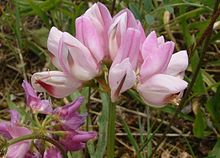Colorful vetch
| Colorful vetch | ||||||||||||
|---|---|---|---|---|---|---|---|---|---|---|---|---|

Red vetch ( Securigera varia ) |
||||||||||||
| Systematics | ||||||||||||
|
||||||||||||
| Scientific name | ||||||||||||
| Securigera varia | ||||||||||||
| ( L. ) Let |
The Vetch ( Securigera varia (L.) Let ; Syn. : Coronilla varia L. ) is a plant type from the subfamily of the Schmetterlingsblütler (Faboideae). It is also called colorful hatchet and was previously assigned to the genus Coronilla . To better illustrate the relationship, some species have now been assigned to the monophyletic genus Securigera .
description
The perennial herbaceous plant with prostrate to ascending angular stems reaches heights of growth of 30 to 60 cm. The leaves are pinnate and have a short stalk with four to twelve pairs of oval leaflets.
Flowering time is from May to September. The flowers stand up to 20 in an umbel. The flag is pink, the boat white with a purple tip. The wings are white. The legume becomes 25 to 50 mm long and is square with a hooked beak and three to six constrictions.
The peacock vetch forms an extensive root system up to a depth of 90 cm and is therefore counted among the raw soil pioneer plants .
The number of chromosomes is 2n = 24.
ecology
The red vetch is a perennial hemicryptophyte and stem plant. It is only capable of flowering from the 2nd year. The leaves show a nyctinasty : they are folded up into a "sleeping position" at night. The plant is deep-rooted and forms root nodules through symbiosis with nitrogen-binding bacteria of the genus Bradyrhizobium .
The flowers are "pollen butterfly flowers " with a pumping mechanism. In contrast to other Fabaceae with a free stamen, no nectar is secreted in the flower , but it is on the fleshy outside of the calyx. Pollinators are honey bees and other hymenoptera . The flowers are self-sterile . Flowering time is from May to September.
The fruits are at maturity perpendicular fracture fruit. They are constricted between the seeds by secondary partitions and disintegrate into 4 to 10 solitary, nut-like, 4 to 5 mg heavy limbs. It is therefore a question of breaking sleeves. The specifically light partial fruits can fall down and cause the force of gravity to spread or they can be carried away by strong winds. It is also possible to spread it as a watery species.
Vegetative propagation occurs through root-borne shoots, i.e. through root brood .
Occurrence
As the site prefers the lime-loving plant dry meadows, forest and Gebüschsäume, Raine , quarries and railway embankments. It is widespread in Central and Southern Europe with a tendency in the northeastern Mediterranean and the Balkans . In Western and Northern Europe it is partly cultivated as a forage plant and is naturalized. It thrives on base-rich, neutral to mild soils and is a character species of the order Origanetalia, but also occurs in societies of the associations Mesobromion, Onopordion or the order Agropyretalia. In the Allgäu Alps, it rises in the Tyrolean part in the Gällewald above Hägerau up to an altitude of 1400 meters.
In Austria it is common in all federal states from the colline to montane altitude .
Toxicity
The whole plant, especially the seeds, is poisonous. The main active ingredients are coronilla glycosides with a digitalis-like effect and psoralen .
Common names
For the Bunte Kronwicke the other German-language trivial names Beilkraut ( Silesia ), Giftwicki ( Switzerland ), Klaft ( Austria ), Kronwicke (Silesia, Swabia ), Peltschen (Swabia), Sheep Lentil (Silesia, Bern ), False Sparsette ( Switzerland) and Bunte Vogelswicken.
literature
- Manfred A. Fischer , Wolfgang Adler, Karl Oswald: Excursion flora for Austria, Liechtenstein and South Tyrol. 2nd, improved and enlarged edition. State of Upper Austria, Biology Center of the Upper Austrian State Museums, Linz 2005, ISBN 3-85474-140-5 .
- Ruprecht Düll , Herfried Kutzelnigg : Pocket dictionary of plants in Germany and neighboring countries. The most common Central European species in portrait. 7th, corrected and enlarged edition. Quelle & Meyer, Wiebelsheim 2011, ISBN 978-3-494-01424-1 .
- Lutz Roth, Max Daunderer , Kurt Kormann: Poisonous plants plant poisons. 6th edition. Nikol, Hamburg 2012, ISBN 978-3-86820-009-6 .
Individual evidence
- ↑ a b Erich Oberdorfer : Plant-sociological excursion flora for Germany and neighboring areas . With the collaboration of Angelika Schwabe and Theo Müller. 8th, heavily revised and expanded edition. Eugen Ulmer, Stuttgart (Hohenheim) 2001, ISBN 3-8001-3131-5 , pp. 605 .
- ↑ Erhard Dörr, Wolfgang Lippert : Flora of the Allgäu and its surroundings. Volume 2, IHW, Eching 2004, ISBN 3-930167-61-1 , p. 146.
- ^ Georg August Pritzel , Carl Jessen : The German folk names of plants. New contribution to the German linguistic treasure. Philipp Cohen, Hannover 1882, p. 113. ( online ).
Web links
- Colorful vetch. In: FloraWeb.de.
- Colorful vetch . In: BiolFlor, the database of biological-ecological characteristics of the flora of Germany.
- Profile and distribution map for Bavaria . In: Botanical Information Hub of Bavaria .
- Securigera varia (L.) Lassen In: Info Flora , the national data and information center for Swiss flora . Retrieved November 21, 2015.
- Thomas Meyer: Data sheet with identification key and photos at Flora-de: Flora von Deutschland (old name of the website: Flowers in Swabia )

